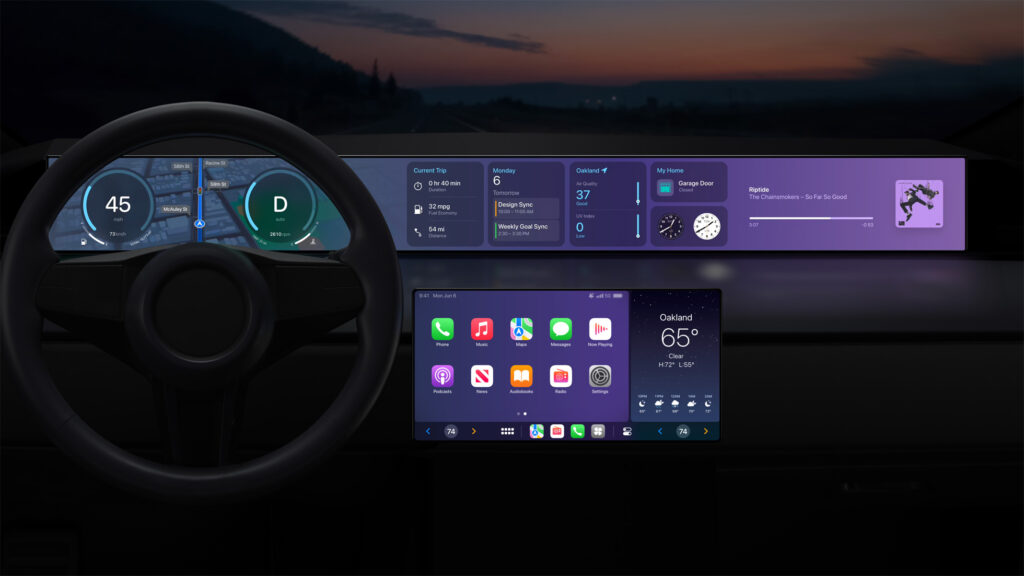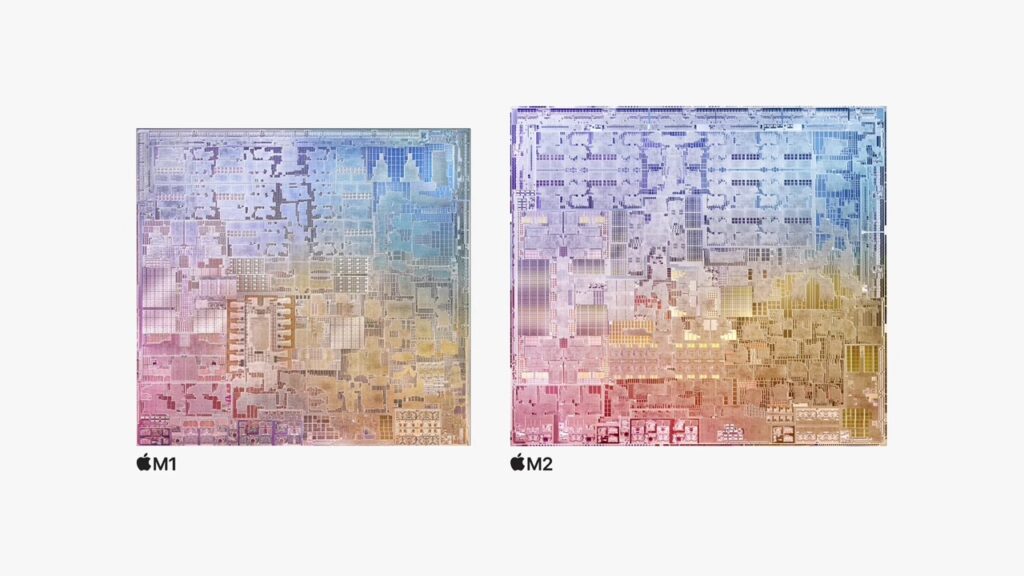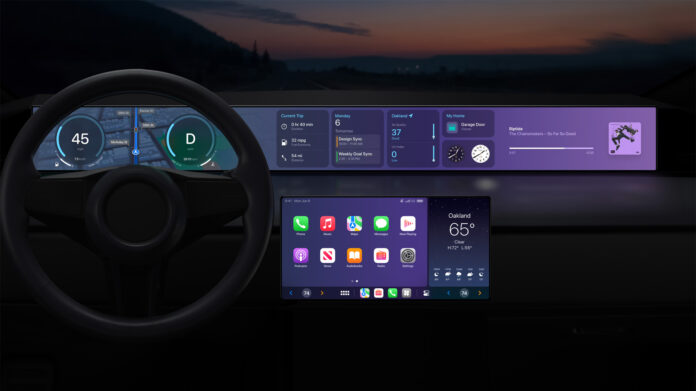New Macs are here; new iOS comes this fall with the next iPhone
Apple Inc. kicked off its annual Worldwide Developer Conference (WWDC) on Monday with an ambitious vision of CarPlay’s future, and promised buy-in from automakers, though it’ll take a while before new features actually make it to cars. Apple also took the wraps off new Macs coming next month, showed off new iPad usability features and previewed new capabilities coming to iPhones this fall.
The annual gathering draws the interest of millions of Apple developers around the globe. As with other tech giants, Apple uses its developer event to frame both public and developer expectations. Apple showcased myriad features and services the company has planned for its fall operating system releases for its phones, watches, computers, and other devices.
Apple took the event virtual in 2020 and 2021 to mitigate pandemic infection risk. This year marks a return to an in-person WWDC, at least on a very limited basis. While the WWDC curriculum is available online to all registered Apple developers, it was accompanied this year by a select in-person event at the company’s Apple Park headquarters in Cupertino, for press, invited guests and lucky Apple devs who were able to score a ticket.
Apple introduced a lot of new technology this week, but it’s probably worth noting what Apple didn’t introduce: Any new Augmented Reality (AR) headset or VR device. While Apple continues to make inroads to improving the AR experience for users of its mobile devices, there’s no Apple-branded headset on the immediate horizon.
On that score, the best guess of the popular Apple supply chain analyst Ming-Chi Kuo of TF International Securities, whose past prognostications have varied widely in their accuracy, is that Apple will debut something next year.
More Apple for your car, but no Apple car
Apple’s new CarPlay implementation is certainly short of a thus-nonexistent, full-stack autonomous vehicle solution. Apple analysts are still tilting at that windmill. But Apple’s new CarPlay implementation is certainly a much more ambitious and complete reach than Android Auto. And it’s Apple’s first public presentation of a software-defined vehicle (SDV) concept which it says is going into production sooner, rather than later.
Presently, CarPlay is simply a bolt-on to vehicle entertainment systems to provide a unified and consistent iOS-style interface: plug your phone into your car et voila, music, directions and other apps are exposed through your vehicle’s in-dash entertainment console. Apple said 98% of new car models sold in the U.S. support CarPlay — in its current implementation. But Apple said the new CarPlay will reconfigure your entire dashboard, working with in-vehicle sensors to integrate more meaningful and important vehicle info.

Apple imagines this new version of CarPlay to provide “an experience that is unified and consistent” across multiple dashboard screens, curated with customized interfaces that can be personalized to suit the driver’s specific tastes. CarPlay will be able to use vehicle data to display speed, fuel level, temperature and other key indicators.
Apple introduced the new CarPlay along with myriad other tentpole features coming to iOS 16 this fall. Don’t count on this being an in-vehicle upgrade for your ’96 Saturn, though: Apple said cars compatible with this new technology will not even be announced until late 2023. Which ostensibly gives CarPlay app makers a year or so to get things with the new tech right, before people start messing around with their custom dash designs.
New M2 Macs
CarPlay’s future regardless, Apple said new Macs are coming next month. Apple unveiled its second generation of Mac computers based around the company’s own silicon. Apple, a long-time Arm licensee, developed its own custom silicon to power the iPhone and the iPad. But for years, Apple’s Mac computers continued to use microprocessors made by Intel and a succession of Intel and third-party graphics processing units (GPUs) from Nvidia and rival AMD.
That changed in 2020 when Apple introduced Macs based around its own CPU designs. The company has since transitioned the Mac line to M-series processors, which it says are more power-efficient than anything offered by Intel. Apple debuted new MacBook Air and 13-inch MacBook Pro computers based around the second-generation M2 chip, which it says is even faster than before, supports more memory and adds new features to the model it replaces.

Apple is making the M2 using a 5-nanometer fabrication process; each chip holds more than 20 billion transistors, 25% higher density than the M1. The M2 sports 100 gigabit per second (GB/s) unified memory bandwidth, 50% more than the chip it replaces. Apple will begin selling the new laptops starting in July at the same price as existing models and has discounted the existing 13-inch MacBook Pro to make room for the new models.
iOS 16: customization and privacy
Apple front-loaded much of the WWDC demonstration around new iOS 16 features with details about the “lock screen” which appears when you first tap your iPhone or iPad — Apple is investing resources in making the lock screen reconfigurable and to support new features exposed in iOS 16. Also center stage is “Safety Check.”
Safety Check is a new privacy feature was developed to keep victims of intimate partner violence safer by removing all access they’ve granted to others. Apple said it worked with victim advocacy groups to develop the new feature, which resets settings for iCloud access, Messages and more easily exposes privacy settings to help users understand who and what they’ve given access to.
Apple touted iCloud Shared Photo library at WWDC as a convenient new way for families and friends to share memories. Of particular note is the ability to edit and recall recently-sent messages, or even recover recently deleted messages. SharePlay is Apple’s FaceTime screen sharing tool, and it’s coming to Messages as well. Apple said it’ll make it easier for Messages users to share synced content like movies or songs and shared playback controls, all within messages.
Other new features include live foreign language and currency translation and a “Visual Look Up” feature, “Apple Pay Later” (a payment program that divides Apple Pay purchases into four equal payments, and more).
iPad and Mac get new Passkey, Continuity features
WWDC gave Apple an opportunity to reveal new versions of the operating systems for its watch, iPad and Mac coming this fall. watchOS 9 delivers an enhanced Workout app, better sleep tracking, an atrial fibrillation (aFib) history feature and a new medications app.
MacOS Ventura is the new Mac release coming later this year. Apple’s emphasizing new productivity features like Stage Manager to better manage the clutter of many open apps. The company has also introduced new features between Mac and iPad to make it easier for users of both to switch between.
Apple received fierce criticism earlier this year for the webcam in its premium-priced $1,599 27-inch Studio Display, which users said produced very low-quality images. Apple offered a firmware patch which improves things, but the truth is that Apple has, for years, short-changed Mac users with mediocre webcam optics, especially compared to the iPhone. So it’s fitting, perhaps, that Apple has addressed the issue by making the iPhone the solution. “Continuity Camera” turns your iPhone into a Mac webcam.
Apple also showcased Passkey, which it says will put an end to passwords. Passkey pairs advanced digital encryption with Apple’s biometric scanning features: FaceID, for face recognition, and Touch ID, its fingerprint-swiping technology. The company says that because the data is stored locally on devices, it can’t be hacked externally and is resistant to social engineering hacking techniques like phishing, as well. The company doesn’t claim Passkey will put an end to password woes altogether, but it’s certainly hoping this is a step in the right direction.

